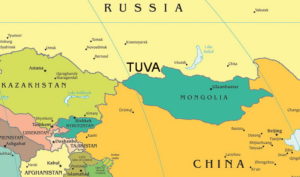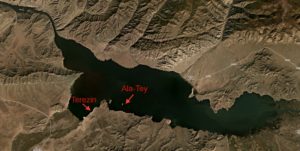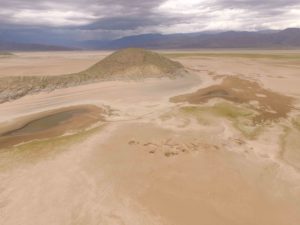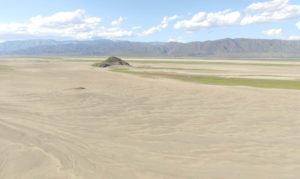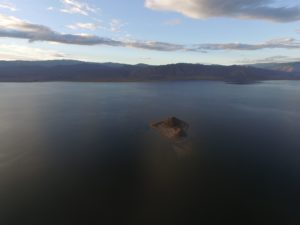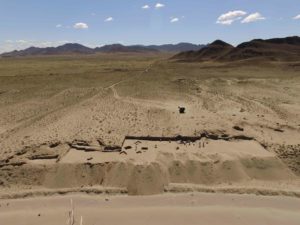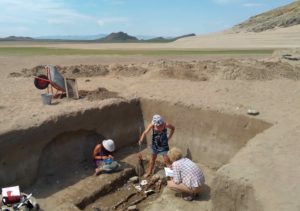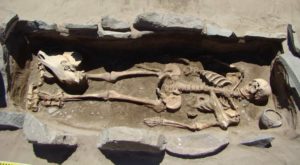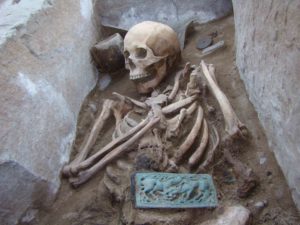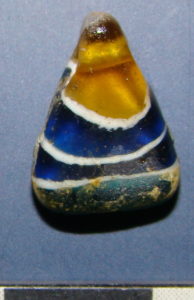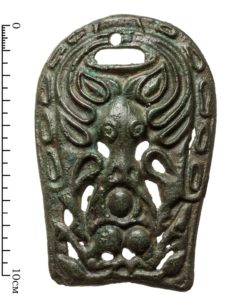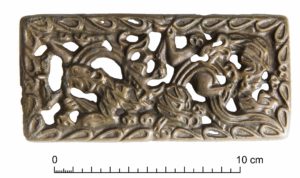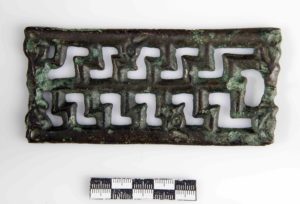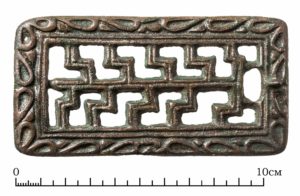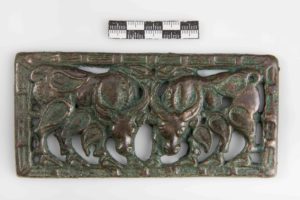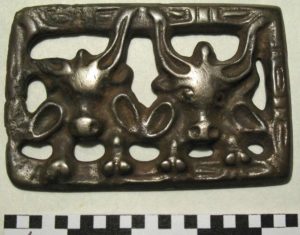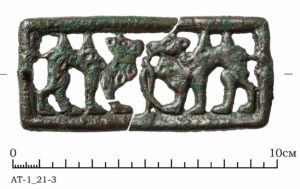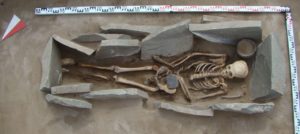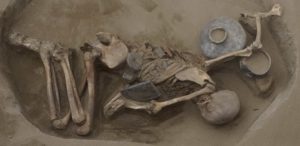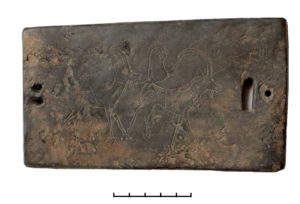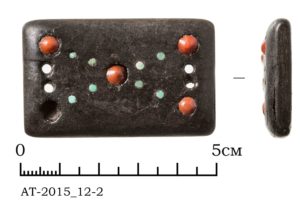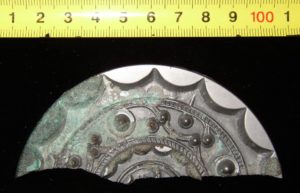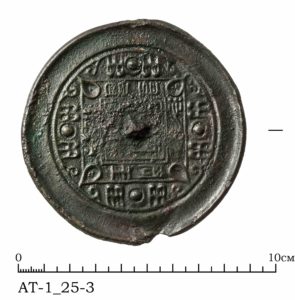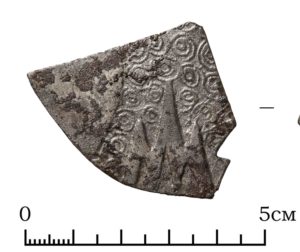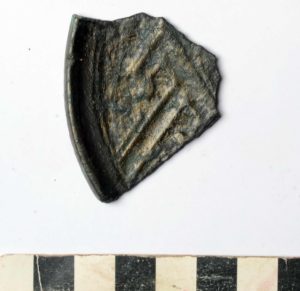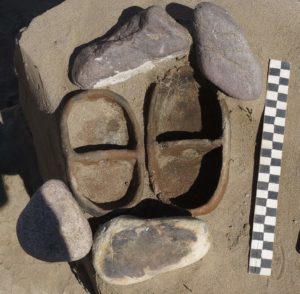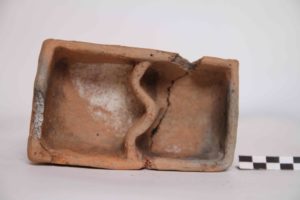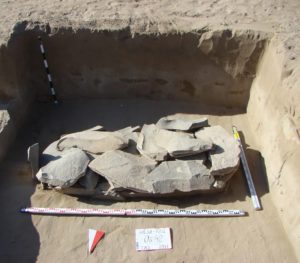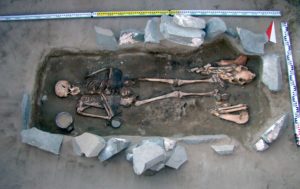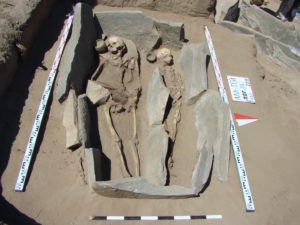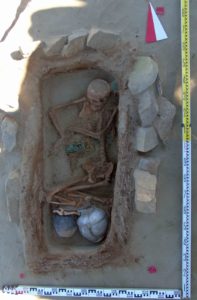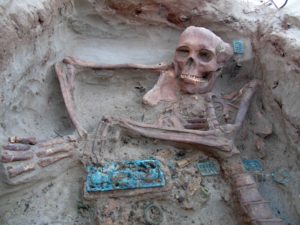Marina Kulinovskaya and Pavel Leus
Institute for the History of Material Culture, Russian Academy of Sciences
Tuva (today, the Tyva Republic, part of the Russian Federation) is a land in the geographic center of Asia, surrounded by mountains and the taiga on the west, east, and north, and by the Mongolian steppes and deserts on the south [Fig. 1]. One finds here all the chief forms of landscape: high mountains, steppe, deserts, forests, and the taiga. The great Siberian river Yenisei arises here. It is a land which was in the epicenter of the majority of historical events, not only of the Sayan-Altai region but of all of Inner Asia. The peoples of the Bronze Age—Scythians, Xiongnu, Xianbei, early Turks, Uighurs, Kyrgyz, and Mongols—all left their traces here in barrows and cemeteries, ancient settlements, fortresses, and other archaeological monuments. Located on a unique crossroads of migration and trade routes, the territory of Tuva could play a central role in the political life of the whole region, witness to which are the remarkable finds in the Uyuk Basin of Tuva from the “royal” barrows of the early Scythian period, Arzhan (Griaznov 1980) and Arzhan-2 (Čugunov et al., 2010).
In the 3rd-2nd centuries BCE the nomadic Xiongnu gathered strength in Inner Asia, extended their influence over a huge territory and, having created a unique nomadic empire, for a long time constituted a formidable adversary of all the surrounding tribes and peoples and Han China as well. The territory of the Sayan-Altai, including Tuva and the Minusinsk Basin, came into the Xiongnu sphere of influence during the northern campaign of the chanyu Mode (Maodun) in 201 BCE.
Traces of the presence of the Xiongnu and their cultural influence have long been known in the Minusinsk Basin: finds include artifacts from the pit graves of the Tes’ Archaeological Culture (Savinov 2009: 102-3) and a palace with Chinese tiles not far from Abakan, which differing opinions associate with the noted military commander Li Ling 李陵 (Kyzlasov 2001: 7) or possibly the self-proclaimed Chinese emperor Lu Fang 盧芳, who had fled to the Xiongnu and lived among them for about a decade in the ‘40s and ‘50s CE (Kovalev 2011: 108-19).
Yet there are not so many traces of a Xiongnu presence in Tuva, on their probable route into the Minusinsk Basin. Exceptions are some chance finds (Kyzlasov 1969: 117-20; Savinov 1969: 104-8) and several excavated barrows of the Xiongnu elite in Central Tuva in the Bay-Dag 2 cemetery (Mandel’shtam and Stambul’nik 1992: 196-98). Unfortunately, the burials at Bay-Dag had been seriously looted in antiquity, and the materials from those excavations have yet to be published. The same is true of the materials of the very interesting Aimyrlyg XXXI cemetery, which is also located in Central Tuva (Stambul’nik 1983). The variety of the burials excavated there suggest that at least some of them belong to the Xiongnu period. Moreover, some of the bronze buckles found there can be associated specifically with the Xianbei people—that is, in their chronology they post-date the period of Xiongnu expansion.
The appearance in Tuva of the Xiongnu and other peoples culturally related to them ought to be reflected as well in new archaeological monuments, in the first instance in the large cemeteries of ordinary people and in settlements known on the territory of the historical range of the Xiongnu in Mongolia, Transbaikalia, and the northern regions of China. Such is the case in the territory of the neighboring Minusinsk Basin, inter alia, in the appearance of subterranean cemeteries of the Tes’ Culture which have a burial inventory that is characteristic of the Xiongnu. For a long time no such archaeological monuments had been found in Tuva, despite the extensive excavations undertaken there in the 1960s-1980s in the area where the Sayan-Shushenskoe hydroelectric station created the reservoir which then flooded a significant part of the Sayan canyon of the Yenisei River and the Central Tuvan Basin. Nonetheless, those excavations established a distinct Ulug-Khem (Tuvan “Great River” = the Yenisei) Culture, which reflected a change in cultural and mortuary traditions during the post-Scythian period (Grach 1971: 99).
In recent years, as a result of regular work on the shores of the Sayan-Shushenskoe reservoir, the Tuvan Archaeological Expedition of the Russian Academy of Sciences Institute for the History of Material Culture (St. Petersburg) found two cemeteries located 4.5 km. apart [Fig. 2], Ala-Tey 1 and Terezin, which unquestionably date to the Xiongnu era and, moreover, to its early period. The excavations at the reservoir are receiving support from the Society for the Exploration of Eurasia (Switzerland)1 and, beginning in 2018, the Russian Geographical Society.
The Ala-Tey 1 cemetery is located at the foot of a small mountain bearing the same name, which stands alone in a wide valley on the left bank of the Upper Yenisei [Fig. 3]. Around this mountain are several cemeteries from different historical epochs, from Scythian times up to the Middle Ages. The Ala-Tey 1 cemetery is a flat grave (or subterranean) cemetery, i.e., there are no signs of it on the surface, making it practically impossible to locate in normal circumstances. The reservoir had washed away the upper layer of sand, revealing the stone slabs of several shallow grave structures. Our expedition discovered them during the archaeological survey undertaken there in 2014.
The first excavations showed that we had found a unique, unlooted cemetery of the Xiongnu period, which both in its culture and chronology was identical with the Terezin cemetery that had been discovered slightly earlier. Since the Ala-Tey site was more compact, it was possible there to excavate over a broad area. Its discovery was a great achievement for archaeologists. The excavations of Ala-Tey have taken place in unusual conditions—since the mid-1980s, the site is located on the bottom of the Sayan-Shushenskoe reservoir. This means that work there is possible only during a brief period, usually 3-4 weeks a year in May to June, between the run-off from the cemetery of melt-water and its re-filling of the reservoir. During that period, the entire valley is like a desert [Fig. 4], but soon it fills up.
During the rest of year the cemetery is at a depth of 16-17 m under water, and the Ala-Tey mountain becomes a small island [Fig. 5].
The Terezin cemetery is located on the sandy, much eroded shore of the reservoir [Fig. 6] against which the water washes in August.
Human bones and stone tomb structures of the first burials found here projected right out of the sand cliffs of the embankment, with artifacts from the destroyed graves scattered along the beach. It was clear that this was a Xiongnu-era cemetery partly destroyed by the reservoir. Judging from the finds, however, it is one that had not been disturbed by ancient looters. Nonetheless, it was possible to find a few intact burials, a process which was hindered by the complicated conditions for carrying out excavations and lack of clarity about the layout of the cemetery. The destroyed burials and the objects from them were found along 1.5 km of the shore, making it necessary to excavate large areas along the cliffs in the most promising places. This project was begun in 2018 with the participation of volunteers from the Russian Geographical Society, the result being that it has been possible to determine a definite structure of the cemetery and also find a large number of intact burials both from the Xiongnu period and later ones that belonged to the Kokel’ Archaeological Culture. Of great interest here was the burial of a female (T/212), who was partly mummified. The slabs of the cover of the stone coffin were fitted together so tightly that the part of the body below the waist was not covered with sand and had become mummified [Fig. 7].
To date more than 90 burials have been uncovered in the Ala-Tey 1 cemetery, and at Terezin more than 30 (part of which were destroyed by the reservoir and part of which date to the later Kokel’ Culture). The excavations of the cemeteries continue, and the exact number of burials in them so far is unknown, though presumably it will be much larger. The preservation of the cemeteries from looting was likely the result of the absence of any over-grave structures, along with the sandy soil and poor ground cover [Fig. 8], which allow the wind to hide all traces of the burials.
Historical information about the social structure of Xiongnu society is known in the first instance from Chinese written sources. An important supplement to them is the material from archaeological excavations on the territory occupied by Xiongnu culture, in the first instance both the elite tombs and the unlooted ordinary burials. A number of the assertions of the Chinese historiographers about Xiongnu culture have already been confirmed by the excavations of the prominent burial complexes of the Xiongnu elite in Mongolia—at Noyon Uul (Rudenko 1962: 6-10; Kozlov 1925: 11-15; Polos’mak and Bogdanov 2015, 2016), Gol-Mod (Miller et al. 2006), and in Transbaikalia (Konovalov 2008; Miniaev and Sakharovskaia 2007; Nikolaev and Miniaev 2017). The same holds true for the excavations of the Xiongnu elite at the Bay-Dag 2 cemetery in Central Tuva (Mandel’shtam and Stambul’nik 1992: 197-98). Efforts have been made to analyze the social structure of the Xiongnu on the basis of the archaeological finds in Transbaikalia (Kradin 2001: 171-81; Kradin, Danilov, and Konovalov 2004: 81-85; Miniaev 2007: 77-80; Brosseder 2007), but all the authors emphasize the insufficiency of evidence for definite conclusions.
The database for this kind of study is regularly supplemented by new finds both from the regions of the historical occupation by the Xiongnu as well as on the periphery of their state, which encompasses, inter alia, the territory of Tuva. Thanks to the fact that the cemeteries of Ala-Tey 1 and Terezin were undisturbed by looters, all the materials obtained from their study can be brought to bear for the reconstruction of the social portrait of the population which left them, something that is impossible or only partly possible in most of the other cases.
The excavations of the cemeteries continue, and a complete picture will be obtained only after they have been completed [Fig. 9].
But it is already possible to reach some preliminary conclusions about a range of questions regarding Xiongnu archaeology in Tuva, among them the interesting one regarding the social status of women. The majority of male burials in the Ala-Tey 1 and Terezin cemeteries seem to be rather poor in regard to the material objects they contain [Figs. 10, 11], while at the same time a number of the female burials seem to be richer, in the first instance on account of the ornaments [Fig. 12] found in them, the composite belts with jet or bronze buckles, Chinese mirrors, etc. [Fig. 13]. The majority of the objects of the grave inventory of the female burials have no analogy in the male burials, with the exception of some common artifacts relating to the domestic economy such as ceramic vessels, iron knives, etc.
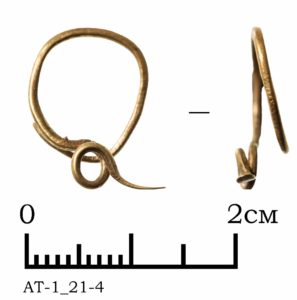
Fig. 12. A gold earring from female grave AT1/21. All artifact photos by Tuvan Archaeological Expedition, Institute for the History of Material Culture, Russian Academy of Sciences.
Without question, the chief element of the female burial array is the belt, whose central detail in many cases is a large openwork buckle or belt plaque made of bronze with zoomorphic and geometric ornament [Fig. 14] or a belt plaque of jet, decorated with engravings or inlays of semiprecious stones [Fig. 15]. Also found are engraved bone buckle-plaques. The belts themselves, whose main material was leather or textile, were decorated around the edges with open-work appliqués of bronze, large and small bronze rings or stone disks, cowrie shells (or frequently their bronze imitations), bronze Chinese coins [Fig. 16], small bells [Fig. 17], and pendants of various materials [Fig. 18], sewn with beaded ornament. In every case, the belts were found in situ in the vicinity of the waist—that is they were worn and were definitely a part of the burial attire. In some Xiongnu cemeteries in Transbaikalia (Miniaev 2007, pls. 36, 90) or in northern China (Kost 2014: pls. 97, 99-100), analogous buckles sometimes are found at the feet or alongside the interred—i.e., the belt was not worn there but placed in the grave as a separate item of the burial inventory.
Belts with large plaque-buckles were most probably part of female ceremonial dress, possibly initially bridal, and subsequently worn only on special festive occasions and thus accompanying the owner into the world beyond the grave. The buckles made of jet, for example, are less sturdy than those made of bronze or bone; their frequent use quickly resulted in damage, which generally could not be repaired. Evidence of this is in the finds of pieces of such buckles, both in burials and in Xiongnu settlements. The jet buckles from Ala-Tey 1 and Terezin nonetheless show signs of wear.
We will briefly describe all of the types of large belt buckles found to date in the cemeteries of Ala-Tey 1 and Terezin:
1. A large bronze belt buckle depicting a bull/yak in full frontal view (from AT1/23, skeleton No. 1) [Fig. 19]. There are no exact analogies, but similar buckles with bulls are known from the Ordos region (Kost 2014: pl. 6).
2. A rectangular bronze buckle depicting combat between two tigers and a dragon (from T/12) [Fig. 20]. Analogous bronze buckles are known, both from Xiongnu burials in Transbaikalia and from private collections (most likely originating in Mongolia and Northern China). One private collection contains a unique example made of dark gray-green nephrite (Rawson 1995: 311-12).
3. A rectangular bronze buckle depicting four writhing snakes [Fig. 21]. Two examples were found (T/1, AT1/43). Analogous buckles and their fragments are known from the monuments of the Tes’ Culture in the Minusinsk Basin (Devlet 1980: 24, pls. 13, 14) and in Xiongnu burials in Transbaikalia (Davydova and Miniaev 2008: 98).
4. A bronze buckle with geometric ornament which forms a stepped lattice, decorated on the edges with the depiction of six animal heads [Fig. 22]. Two examples were found in the Terezin cemetery (T/5 and a chance find from a destroyed burial). Analogies are known from the Minusinsk Basin and in chance finds (Devlet 1980: pls. 16-17).
5. A bronze buckle with geometric ornament which forms a stepped lattice [Fig. 23], similar to the preceding, but lacking the animal heads (AT1/2). Analogies are known from the Minusinsk Basin in chance finds and from the materials of the Tes’ graves (Devlet 1980: 16-17; Kuz’min 2011: 196). In the Terezin cemetery were five similar small appliqués, belt decorations in a rich female burial (T/31), where the large central buckle depicted horses in combat.
6. A rectangular buckle depicting two confronted standing bulls/yaks [Fig. 24], their heads facing the viewer.
Seven examples were found (T/13, T/14, AT1/11, AT1/19, AT1/48, AT1/50, AT1/64). They all vary in measurements and likely were cast in different molds. Analogies have been found especially in the Minusinsk Basin, the provenance of several intact buckles and fragments (altogether 19 examples), most from chance finds but some from excavated burials (Devlet 1980: 20-21; pls. 1-6). One buckle was found in a burial dated to the early Han (2nd-1st centuries BCE) in Manchuria (Kost 2014: 221, pl. 17), and several chance finds probably are from the territory of Inner Mongolia (Brosseder 2011: 372, 419; Rawson and Bunker 1990: cat. no. 222). It is possible that this subject was the basis for the depictions on two small appliqués from the eroded burial T/5, showing two front-facing bulls/yaks [Fig. 25], decorations for a belt that had a large buckle plaque with geometric ornament and six animal heads.
7. A bronze buckle depicting two confronted camels [Fig. 26] (from AT1/21). Several random finds of analogous buckles come from northern China; half of such a buckle was found in the excavations of the cemetery at Daodunzi (Devlet 1980: Fig. 2.2; Kost 2014: pl. 23).
8. A fragment of a bronze buckle depicting a horse [Fig. 27] in recumbent position, legs drawn under it (AT1/23, skeleton No. 2). It was on a belt along with unidentifiable fragments of another buckle. Several similar buckles with a single horse whose legs are drawn under it are known from chance finds in Northern China (Wagner and Butz 2007: 2-3). One example comes from the Daodunzi Cemetery (Kost 2014: pls. 7, 8).
9. A bronze buckle depicting two horses or Przewalski horses in combat, biting each other [Fig. 28]. Two examples were found (AT1/42; T/31). Analogies are known from the Minusinsk Basin, Transbaikalia and China (Miniaev 2007: pls. 1, 3, 84, 88, 91; Kost 2014: 116-17; pls. 43, 44; Brosseder 2011: 364-370, 417). In one of the burials at Terezin (T/19) that had been eroded by water was a small appliqué with the same subject, apparently part of a collection of several similar appliqués which had decorated a woman’s belt.
10. A paired bronze buckle depicting two fantastic creatures [Fig. 29] resembling dragons with braided tails, horns, and goat snouts (AT1/47). Analogous examples are known mainly from northern China (Kost 2014: 113-14; pls. 32-33).
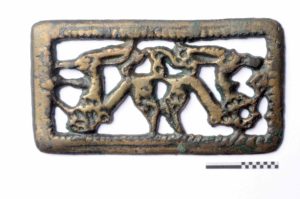
Fig. 29. A bronze openwork buckle (one of a pair) depicting two dragon-like creatures or Siberian ibex, from grave AT 1/47.
Jet belt buckle plaques and appliqués previously had not been found in Tuva [Fig. 30].
In the Ala-Tey 1 and Terezin cemeteries, large jet buckle plaques were found in five graves (AT1/29, 35, 86, T/21, T/23). The plaque from AT1/29 measures 18 x 9 cm [Fig. 31].
It is decorated with a dot pattern, the indentations with color inlay of turquoise, carnelian, and mother-of-pearl. The buckles from AT1/35 [Fig. 32] and T/23 are decorated in the same style.
On the short sides of the buckle are openings: on one side there are two round holes for securing the buckle to the belt; on the other a single, oval one, likely for the fastening of the buckle. In grave AT1/86 an aged woman had a complete composite jet belt [Fig. 33]—a large buckle plaque, rectangular appliqués, and a substantial ring.
On the buckle was an interesting engraving depicting two walking mountain goats, with arrows falling on them. On the right are a bow and arrow, suggesting the presence of a bowman. Above one of the goats is an image of a horse lying upside down and with a twisted croup. In this way, elements of the Scythian animal style were combined with the Xiongnu pictorial tradition [Fig. 34].
On the belt of a young woman from grave T/21 was a jet buckle plaque engraved with a tamgha-like symbol resembling an hour-glass or Wu symbol as seen in Chinese Wu Zhu 五銖 coins. A jar-shaped vessel set in that grave is analogous to one from grave AT1/86.
The small belt appliqués measure 4-5 x 2.5-3 cm. On both short sides of the plaques are holes for attaching them to the belt. One of the appliqués (AT1/12) was decorated with an X-shaped dot design, in whose indentations were color inlays [Fig. 35].
Similar items, among them ones with both identical and different inlays, are known in Xiongnu-era archaeological monuments in Transbaikalia—in the Ivolga cemetery (Davydova 1996: 20-21) and in the settlement (Davydova 1995: 39), in the Dyrestui cemetery and the Dureny settlement (Davydova and Miniaev 2008, figs. 34, 87-89), and in Il’movaia pad’ barrow No. 54 (Konovalov 2008: Figs. 48, 49). Large plaques with such ornaments have been found in Central Asia (Brosseder 2011: 361; Raev 2017). Several examples have been found in the Tes’ Culture graves in the Minusinsk Basin (Kuz’min 2011: 197, 352, pl. 41; fig. 41). Other examples come from Mongolia (Treasures 2011: 134-35).
Chinese bronze mirrors have been found so far exclusively in the female burials and usually are placed on the left or right of the breast, sometimes next to the shoulder or skull. For example, in grave T/21 a mirror lay to the right of the head in a special pouch or wooden box. The majority of the mirrors are examples dating to the Western Han period (2nd-1st centuries BCE), and for the most part these are not even original Chinese mirrors [Fig. 36] but rather their local copies [Fig. 37].
In four instances mirrors were found which date to the pre-Han period in China [Figs. 38-39], i.e., to the end of the Warring States Period, which in Tuva corresponds to the late Scythian period.
For the most part, mirrors were found in rich burials with the openwork buckles, but occasionally in a grave with a rich composite belt there is no mirror. An important detail for the chronology of the monuments is the absence here of mirrors from the Eastern Han period (i.e., the 1st-2nd centuries CE), among them the widely distributed TLV mirrors.
The male belts usually involved round or rectangular-framed iron buckles, some rather large, and also iron rings. A characteristic feature of a male belt also is the bronze spoon-like strap tip [Fig. 40], which is not found in female burials.
While it may seem unusual, in male burials there are practically no weapons—in Terezin there were only two instances of burials of archers, which contained bone strengtheners for complex bows and arrowheads; at Ala-Tey, five graves contained bows and only one of them arrowheads.
The basic types of ceramic vessels—a single shallow vessel or one paired with a jar-shaped vessel—were found in all the burials: male, female, and child [Fig. 41]. The same was true of a type of ceramic vessel that is unique to the region, and which was found for the first time in the Ala-Tey 1 cemetery—these are small vessels with an internal partition at whose base usually is a round hole [Figs. 42-43]. All of them were discovered at the level of the ancient surface, in the center or at the edge of the grave pit. They have various shapes—square, round, oval or rectangular. One may surmise that these were lamps, lighted over the grave or around its periphery at the conclusion of or subsequent to the funeral ceremony.
There was no correlation between particular types of grave structures in either cemetery or gender. Both male and female burials were in stone cists [Fig. 44], wooden coffins with stone siding [Fig. 45], and in simple earthen pits [Fig. 46].
The depth of the graves also varied from literally 30 cm to 2 m. Male, female, and child burials were found with the body on the side or supine with flexed or extended legs. However, in the Ala-Tey 1 cemetery, the majority of the bodies were extended and supine (more than 90%), whereas in Terezin they had flexed legs [Figs. 47-48].
A distinctive feature of the extended male and female burials at Ala-Tey was the position of the arms: for the men, extended down along the body, but for the women, bent at the elbows [Fig. 49] and lying on the waist or folded on the breast, with some cases where one arm was at the waist and the second bent to the breast or shoulder.
Thus, in Tuva, the arrival of the Xiongnu or some tribe related to them culturally is reflected in the replacement of the Scythian-type Uyuk-Saglyn Culture by the Ulug-Khem Archaeological Culture. As a result, the characteristic Scythian-period features, such as collective burials in wooden chambers and the material culture associated with them, disappear. Mortuary monuments of different types appear: ordinary subterranean burials in stone cists, in wooden coffins or frames, simple earthen pit burials, and also large elite barrows with dromoses. The majority of the bodies are extended supine ones, though sometimes they are in the flexed position. The material culture corresponds entirely to that of the Xiongnu, including the most prominent examples of decorative applied arts, weaponry, ceramics, décor, and Chinese imports.
Also very indicative are the changes in the distribution of grave inventory by gender. If in Scythian times in Tuva the more valuable objects were usually found in male burials, then in the Ulug-Khem Culture, they are in female burials. This could be evidence about the higher status of women in Xiongnu society than in the preceding Scythian society. However, the richer grave inventory of female burials might merely attest to the more beautiful ceremonial attire of women, which was natural for most nomadic and sedentary societies in Eurasia. Here, in all likelihood, an important role was played as well by the social position of buried women in their society: whether or not they were married, came from a rich, influential family or from a poor one, etc. Both cemeteries include rich and poor female burials. The same is true of the children’s graves—some have modest burial inventory, but some relatively rich [Fig. 50], including various kinds of ceramic vessels, beads, and other ornaments, along with Chinese pendant bells, etc., which are also typical for the female burials. Nonetheless, it is as yet premature to reach a final conclusion about such matters.
Who were the people buried at Ala-Tey and Terezin? So far one might propose that this was some group of nomads who were part of the multi-ethnic Xiongnu confederation and who had entered Tuva during their expansion to the north. Until then they might have lived somewhere on the northern borders of China, where they could obtain Chinese wares such as mirrors, coins, ornaments, etc.; after that they set off on the long march which brought them to Tuva. Once there, no longer having access to original Chinese objects, they had to copy them on their own: the majority of copies of the Chinese mirrors and openwork buckles are made of bronze, which was of local origin, as metallurgical analysis has demonstrated (Khavrin 2011; 2016). The time when these people headed into Tuva so far seems to have been the beginning of the Western Han period, i.e., the 2nd century BCE. Evidence for this includes the Chinese mirrors from precisely that period or even the preceding one and the absence of later examples. Accelerator Mass Spectrometry (AMS) dating of some burials at Ala-Tey and Terezin also points to the 2nd-1st centuries BCE.
Historically, that was precisely the time of the northern campaigns of the Xiongnu into the Sayan-Altai and the subsequent inclusion of that region into the sphere of their cultural influence. It is no surprise that in the North, the very location of the main mass of known archaeological monuments of the Xiongnu epoch is precisely in Central Tuva, in the geopolitically important place where Yenisei enters the Sayan canyon, the historic route from there northwards into the Minusinsk Basin. The people who arrived there could have been a military force or loyal settlers, who replaced the local Scythian population and assimilated its remnants. The burials with extended legs found in both cemeteries could be connected with Scythian mortuary traditions. A more precise answer to the question of this population’s origin may come from the results of palaeogenetic analysis.
The plan is to continue the excavations in the Ala-Tey 1 and Terezin cemeteries in 2019. New discoveries await the archaeologists, discoveries which will help better to understand the historical processes occurring at that time in Inner Asia.
– translated by Daniel C. Waugh
About the Authors
Marina Kilunovskaya is Senior Researcher in the Department of Archaeology of Central Asia and the Caucasus at the Institute for the History of Material Culture in the Russian Academy of Sciences. She has been conducting excavations in Tuva since 1980. In recent years, she has headed the Tuva Archaeological Expedition of the Institute for the History of Material Culture. She is the author of many scientific publications on the archaeology and rock art of Tuva, Central Asia, and South Siberia. Her research interests include the study of the Bronze Age and Scythian era, rock art, and deer stones. E-mail: <kilunmar@mail.ru>.
Pavel Leus is a member of the Tuva Archaeological Expedition organized by the Institute for the History of Material Culture in the Russian Academy of Sciences. He has worked on excavations in Tuva since 1991, including the last twelve years on Xiongnu-era burial grounds near the Sayan-Shushenskoe reservoir. He is the author of numerous publications on the archaeology and ethnography of Tuva and Central Asia. His research interests include the Xiongnu and Scythian eras, ancient Turkic peoples, and the ethnography of Central Asia and South Siberia. E-mail: <leuss@web.de>.
References
Brosseder 2007
Ursula Brosseder. “Fremde Frauen in Ivolga?” In: M. Blečićet al., eds., Scripta praehistorica in honorem Biba Teržan, Ljubljana, 2007: 883-93.
Brosseder 2011
Ursula Brosseder. “Belt Plaques as an Indicator of East-West Relations in the Eurasian Steppe at the Turn of the Millennia.” In: Ursula Brosseder and Bryan Miller, eds., Xiongnu Archaeology: Multidisciplinary Perspectives of the First Steppe Empire in Inner Asia. Bonn Contributions to Asian Archaeology. Vol. 5. Bonn, 2011: 350-424.
Čugunov et al. 2010
Konstantin V. Čugunov, Hermann Parzinger, and Anatoli Nagler. Der skythenzeitliche Fürstenkurgan Aržan 2 in Tuva. Archäologie in Eurasien 26. Steppen Völker Eurasiens 3. Mainz, 2010.
Davydova 1995
Antonina Vladimirovna Davydova. Ivolginskii arkheologicheskii kompleks. T. 1. Ivolginskoe gorodishche [The Ivolga Archaeological Complex. Vol. 1. The Ivolga Hillfort]. Sankt-Peterburg, 1995.
Davydova 1996
Antonina Vladimirovna Davydova. Ivolginskii arkheologicheskii kompleks. T. 2. Ivolginskii mogil’nik [The Ivolga Archaeological Complex. Vol. 2. The Ivolga Cemetery]. Sankt-Peterburg, 1996.
Davydova and Miniaev 1993
Antonina Vladimirovna Davydova and Sergei Stepanovich Miniaev. “Novye nakhodki nabornykh poiasov v Dyrestuiskom mogil’nike [New discoveries of composite belts in the Dyrestui cemetery]. Arkheologicheskie vesti 2 (1993): 55-65.
Davydova and Miniaev 2008
Antonina Vladimirovna Davydova and Sergei Stepanovich Miniaev.The Xiongnu Artistic Bronzes: New Discoveries in Russia/ Khudozhestvennaia bronza siunnu; Novye otkrytiia v Rossii. Sankt-Peterburg, 2008.
Devlet 1980
Marianna Artashirovna Devlet. Sibirskie poiasnye azhurnye plastiny II v. do n.e-I v. n.e. [Siberian openwork belt plaques, 2nd century BCE-1st century CE]. Svod arkheologicheskikh istochnikov, Vyp. D 4-07. Moskva, 1980.
Grach 1971
Aleksandr Danilovich Grach. “Novye dannye o drevnei istorii Tuvy [New data on the ancient history of Tuva].” Uchenye zapiski Tuvinskogo nauchno-issledovatel’skogo instituta iazyka, literatury i istorii (Kizyl) 15 (1971): 93-106.
Griaznov 1980
Mikhail Petrovich Griaznov. Arzhan. Tsarskii kurgan ranneskifskogo vremeni. [Arzhan: a royal barrow of the early Scythian period]. Leningrad, 1980.
Khavrin 2011
Sergei Vladimirovich Khavrin. “Metal of the Xiongnu Period from the Terezin Cemetery, Tuva.” In: Ursula Brosseder and Bryan Miller, eds., Xiongnu Archaeology: Multidisciplinary Perspectives of the First Steppe Empire in Inner Asia. Bonn Contributions to Asian Archaeology. Vol. 5. Bonn, 2011: 537-38.
Khavrin 2016
Sergei Vladimirovich Khavrin. “Metall epokhi khunnu mogil’nika Terezin I (Tuva) [Metal of the Xiongnu period of the Terezin I (Tuva) cemetery]” [Appendix to Leus and Bel’skii 2016]. Arkheologicheskie vesti 22 (2016): 105-7.
Kilunovskaia and Leus 2017a
Marina Evgen’evna Kilunovskaia and Pavel Mikhailovich Leus. “Iskusstvo kontsa pervogo tysiacheletiia do n. e. v Tuve” [Art of the end of the first millennium BCE in Tuva]. Kratkie soobshcheniia Instituta arkheologii, Vyp. 247 (2017a): 87-104.
Kilunovskaia and Leus 2017b
Marina Evgen’evna Kilunovskaia and Pavel Mikhailovich Leus. “Mogil’nik Ala-Tei i pamiatniki khunnu v Tve” [The Ala-Tei cemetery and Xiongnu monuments in Tuva]. In: D. G. Savinov, ed., Rannii zheleznyi vek ot rubezha er do serediny I tys. n.e. Dinamika osvoeniia kul’turnogo prostranstva. Materialy IV nauchnoi konferentsii “Arkheologicheskie istochniki i kul’turogenez,” 14-18 noiabria 2017 g.Sankt-Peterburg, 2017b: 72-75.
Konovalov 2008
Prokopii Batiurovich Konovalov. Usypal’nitsa khunnskogo kniazia v Sudzhi. (Il’movaia pad’, Zabaikal’e). Ulan-Ude, 2008. Also in English: The Burial Vault of a Xiongnu Prince at Sudzha (Il’movaia pad’, Transbaikalia). Bonn Contributions to Asian Archaeology. Vol. 3. Bonn, 2008.
Kost 2014
Catrin Kost. The Practice of Imagery in the Northern Chinese Steppe (5th-1st centuries BCE). Bonn Contributions to Asian Archaeology. Vol. 6. Bonn, 2014.
Kovalev 2011
Aleksei Anatol’evich Kovalev. “Imperator Kitaia v khakasskoi stepi [А Chinese emperor in the Khakass steppe].” Khunnu: arkheologiia, proiskhozhdenie kul’tury, etnicheskie osobennosti. Ulan-Ude, 2011: 77-114.
Kozlov 1925
Petr Kuz’mich Kozlov. “Severnaia Mongoliia—Noin-ulinskie pamiatniki [Northern Mongolia—the Noyon Uul monuments].” In: Kratkie otchety ekspeditsii po issledovaniiu Severnoi Mongolii v sviazi s Mongol’sko-Tibetskoi ekspeditsiei P. K. Kozlova. Leningrad, 1925: 1-12.
Kradin 2001
Nikolai Nikolaevich Kradin. Imperiia Khunnu [The Xiongnu empire]. Moskva, 2001.
Kradin, Danilov, and Konovalov 2004
Nikolai Nikolaevich Kradin, Sergei Vladimirovich Danilov, and Prokopii Batiurovich Konovalov. Sotsial’naia struktura khunnov Zabaikal’ia [The social structure of the Transbaikal Xiongnu]. Vladivostok, 2004.
Kuz’min 2011
Nikolai Iur’evich Kuz’min. Pogrebal’nye pamiatniki khunno-sian’biiskogo vremeni v stepiakh Srednego Eniseia: Tesinskaia kul’tura [Mortuary monuments of the Xiongnu-Xianbei period in the steppes of the Middle Yenisei: the Tes’ culture]. Sankt-Peterburg, 2011.
Kyzlasov 1969
Leonid Romanovich Kyzlasov. “O pamiatnikakh rannikh gunnov” [On the monuments of the ancient Xiongnu]. Drevnosti Vostochnoi Evropy. Moskva, 1969: 115-24.
Kyzlasov 2001
Leonid Romanovich Kyzlasov. Gunnskii dvorets na Enisee:Problema rannei gosudarstvennosti Iuzhnoi Sibiri. [A Xiongnu palace on the Yenisei: the problem of early statehood in southern Siberia]. Moskva, 2001.
Leus 2011
Pavel Mikhailovich Leus. “New Finds from the Xiongnu Period in Central Tuva. Preliminary Communication.” In: Ursula Brosseder and Bryan Miller, eds., Xiongnu Archaeology: Multidisciplinary Perspectives of the First Steppe Empire in Inner Asia. Bonn Contributions to Asian Archaeology. Vol. 5. Bonn, 2011: 515-36.
Leus 2017
Pavel Mikhailovich Leus. “Radiouglerodnye daty iz khunnskikh mogil’nikov Ala-Tei i Terezin v Tuve” [Radio-Carbon dates from the Xiongnu cemeteries of Ala-Tei and Terezin in Tuva]. In: A. S. Vdovin and N. P. Makarov, eds., Mezhdistsiplinarnye issledovaniia v arkheologii, etnografii i istorii Sibiri. Materialy mezhdunarodnoi nauchnoi konferentsii Krasnoiarsk, 27-30 sentiabria 2017 g., Krasnoiarsk, 2017: 181-84.
Leus and Bel’skii 2016
Pavel Mikhailovich Leus and Stanislav Viktorovich Bel’skii. “Terezin I—mogil’nik epokhy Khunnu v Tsentral’noi Tuve” [Terezin I—a cemetery of the Xiongnu era in central Tuva]. Arkheologicheskie vesti 22 (2016): 93-104.
Mandel’shtam and Stambul’nik 1992
Anatolii Maksimilianovich Mandel’shtam and El’vira Ustinovna Stambul’nik. “Gunno-Sarmatskii period na territorii Tuvy” [The Xiongnu-Sarmatian period on the territory of Tuva]. In: M. G. Moshkova, ed., Stepnaia polosa Aziatskoi chasti SSSR v skifo-sarmatskoe vremia, Moskva, 1992: 196-205.
Miller et al. 2006
Bryan Miller, Francis Allard, Diimaazhav Erdenebaatar, and Christine Lee. “A Xiongnu Tomb Complex: Excavations at Gol Mod 2 Cemetery, Mongolia (2002-2005).” Mongolian Journal of Archaeology, Anthropology and Ethnology 2/2 (271) (2006): 1-21.
Miniaev 2007
Sergei Stepanovich Miniaev. Dyrestuiskii mogol’nik [The Dyrestui cemetery]. 2-e izd., dop. Arkheologicheksie pamiatniki siunnu. Vyp. 3. Sankt-Peterburg, 2007 (1st ed., 1998).
Miniaev and Sakharovskaia 2007
Sergei Stepanovich Miniaev and Lidiia Mikhailovna Sakharovskaia. “Elitnyi kompleks zakhoronenii khunnu v padi Tsaram” [An elite Xioungnu burial complex in the Tsaram Valley]. Rossiiskaia arkheologiia 2007/1: 159-66.
Nikolaev and Miniaev 2017
Nikolai Nikolaevich Nikolaev and Sergei Stepanovich Miniaev. “Raboty Tsentral’no-Aziatskoi arkheologicheskoi ekspeditsii na mogil’nike Orgoiton [Work of the Inner Asian Archaeological Expedition at the Orgoiton cemetery].” Arkheologicheskii sbornik 41. Materialy i issledovaniia po arkheologii Evrazii. Sankt-Peterburg, 2017: 143-58.
Polos’mak and Bogdanov 2015
Natal’ia Viktorovna Polos’mak and Evgenii Sergeevich Bogdanov. Kurgany Sutszukte (Noin-Ula, Mongoliia) [The Süzhigt Barrows (Noyon Uul, Mongolia)]. Novosibirsk, 2015.
Polos’mak and Bogdanov 2016
Natal’ia Viktorovna Polos’mak and Evgenii Sergeevich Bogdanov.Noin-Ulinskaia kollektsiia. Rezul’taty rabot rossiisko-mongol’skoi ekspeditsii 2006-2012 gg. [The Noyon Uul Collection. Results of the work of the Russo-Mongolian Expeditions 2006-2012]. Novosibirsk, 2016.
Raev 2017
Boris Aronovich Raev. “Gagatovye priazhki iz Zhutovskogo mogil’nika. Arkheologicheskie priznai migratsii” [Jet Buckles from the Zhutovskii Cemetery. Archaeological Signs of Migration]. In: L. B. Vishniatskii, ed., Ex Ungue Leonem. Sbornik statei k 90-letiiu L’va Samuilovicha Kleina, Sankt-Peterburg, 2017: 291-305.
Rawson 1995
Jessica Rawson. Chinese Jade: From the Neolithic to the Qing. London, 1995.
Rawson and Bunker 1990
Jessica Rawson and Emma C. Bunker. Ancient Chinese and Ordos Bronzes. Hong Kong, 1990.
Rudenko 1962
Sergei Ivanovich Rudenko. Kul’tura khunnov i noinulinskie kurgany [The culture of the Xiongnu and the Noyon Uul barrows]. Moskva-Leningrad, 1962.
Savinov 1969
Dmitrii Glebovich Savinov. “Pogrebenie s bronzovoi bliakhoi v Tsentral’noi Tuve” [A burial with a bronze plaque in central Tuva]. Kratkie soobshcheniia Instituta arkheologii, Vyp. 119 (1969): 104-8.
Savinov 2009
Dmitrii Glebovich Savinov. Minusinskaia provintsiia Khunnu (Po materialam arkheologicheskikh issledovanii 1984-1989 gg.)[The Minusinsk Province of the Xiongnu (from materials of the archaeological investigations of 1984-1989]. Sankt-Peterburg, 2009.
Stambul’nik 1983
El’vira Ustinovna Stambul’nik. “Novye pamiatniki gunno-sarmatskogo vremeni v Tuve (nekotorye itogi rabot)” [New monuments of the Xiongnu-Sarmatian period in Tuva (some results of the work)]. In: V. M. Masson, ed., Drevnie kul’tury evraziiskikh stepei. Po materialam arkheologicheskikh rabot na novostroikakh, Leningrad, 1983: 34-41.
Treasures 2011
Treasures of the Xiongnu. Culture of Xiongnu, the First Nomadic Empire in Mongolia/ Khünnügiin öv. Nüüdelchdiin ankhny tör—Khünnügürnii soël. G. Eregzen, ed. Ulaanbaatar, 2011.
Wagner and Butz 2007
Mayke Wagner and Herbert Butz. Nomadenkunst. Ordosbronzen der Ostasiatischen Kunstsammlung. Museum für Asiatische Kunst, Staatliche Museen zu Berlin. Archäologie in Eurasien 23. Mainz, 2007.
Endnotes
1 Reports on the several seasons of excavation in Tuva supported by the Society are available online: http://www.exploration-eurasia.com/inhalt_english/frameset_projekt_4.html
2 The abbreviations used here indicate the site (AT1 = Ala-Tey1; T = Terezin) and, following the forward slash (/), the number of the grave.

